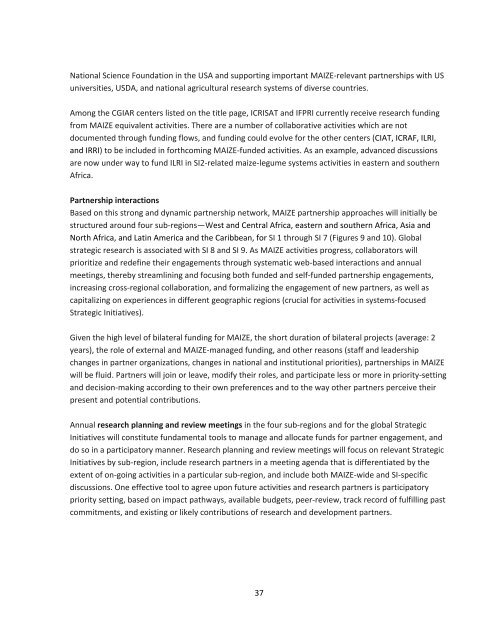Download - Maize
Download - Maize
Download - Maize
Create successful ePaper yourself
Turn your PDF publications into a flip-book with our unique Google optimized e-Paper software.
National Science Foundation in the USA and supporting important MAIZE‐relevant partnerships with US<br />
universities, USDA, and national agricultural research systems of diverse countries.<br />
Among the CGIAR centers listed on the title page, ICRISAT and IFPRI currently receive research funding<br />
from MAIZE equivalent activities. There are a number of collaborative activities which are not<br />
documented through funding flows, and funding could evolve for the other centers (CIAT, ICRAF, ILRI,<br />
and IRRI) to be included in forthcoming MAIZE‐funded activities. As an example, advanced discussions<br />
are now under way to fund ILRI in SI2‐related maize‐legume systems activities in eastern and southern<br />
Africa.<br />
Partnership interactions<br />
Based on this strong and dynamic partnership network, MAIZE partnership approaches will initially be<br />
structured around four sub‐regions—West and Central Africa, eastern and southern Africa, Asia and<br />
North Africa, and Latin America and the Caribbean, for SI 1 through SI 7 (Figures 9 and 10). Global<br />
strategic research is associated with SI 8 and SI 9. As MAIZE activities progress, collaborators will<br />
prioritize and redefine their engagements through systematic web‐based interactions and annual<br />
meetings, thereby streamlining and focusing both funded and self‐funded partnership engagements,<br />
increasing cross‐regional collaboration, and formalizing the engagement of new partners, as well as<br />
capitalizing on experiences in different geographic regions (crucial for activities in systems‐focused<br />
Strategic Initiatives).<br />
Given the high level of bilateral funding for MAIZE, the short duration of bilateral projects (average: 2<br />
years), the role of external and MAIZE‐managed funding, and other reasons (staff and leadership<br />
changes in partner organizations, changes in national and institutional priorities), partnerships in MAIZE<br />
will be fluid. Partners will join or leave, modify their roles, and participate less or more in priority‐setting<br />
and decision‐making according to their own preferences and to the way other partners perceive their<br />
present and potential contributions.<br />
Annual research planning and review meetings in the four sub‐regions and for the global Strategic<br />
Initiatives will constitute fundamental tools to manage and allocate funds for partner engagement, and<br />
do so in a participatory manner. Research planning and review meetings will focus on relevant Strategic<br />
Initiatives by sub‐region, include research partners in a meeting agenda that is differentiated by the<br />
extent of on‐going activities in a particular sub‐region, and include both MAIZE‐wide and SI‐specific<br />
discussions. One effective tool to agree upon future activities and research partners is participatory<br />
priority setting, based on impact pathways, available budgets, peer‐review, track record of fulfilling past<br />
commitments, and existing or likely contributions of research and development partners.<br />
37

















